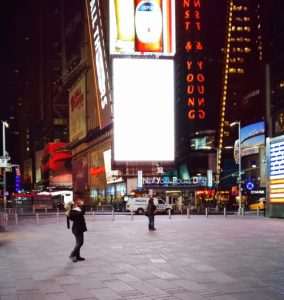
A couple of blocks south of Times Square there’s a street corner that has become something of a de facto campground for a few of the homeless.
There’s really nothing all that unique about the corner, but it does have a stretch of subway grates that provide some heat. And there’s one of the free wi-fi and charging stations the city put in place awhile back when it started getting rid of pay phones.
For the past three-and-a-half years I’ve walked by it around 2:30 in the morning on the way to work. Regardless of the season, or the conditions, there is almost always someone sitting, sleeping, or hanging out on the corner.
A few years back there were a couple of regulars. One was a white man who looked to be in his fifties, maybe older. He’d sit on one of the little red chairs used at the tables and public seating areas in Times Square. Often he’d be working a crossword puzzle, using the dim yellowish light from the closed stores and streetlights.
Over time, he was replaced by an older African-American woman. She sat on one of the little red chairs, or her suitcases, which she had fashioned into a makeshift chair. Her belongings were usually assembled neatly around her, close enough so everything was within reach.
She always she sat facing Time Square, head up and staring at the flashing lights a few blocks north. I don’t remember exactly when it was when she stopped sitting on the corner, but I do know who has taken her place.
It’s a group of young guys who appear to be in their twenties, maybe their thirties. I counted four of them on the corner on a recent morning, curled up under blankets and sleeping over the subway grates. It was eighteen degrees at the time. Without the wind.
This group has been there a while, spring, summer, fall and now winter. On my way into work in the dark, I’ve passed them splitting a pizza with a larger group. Or just sitting around talking. KInd of the behavior you’d expect from a group of post-college age kids. Except they’re sitting on a sidewalk in New York, not in someone’s apartment.
Late last year, the Coalition for the Homeless said homelessness in New York City had hit the highest levels since the Great Depression. There were almost 63,000 homeless people sleeping in the city’s municipal shelter system every night.
But that’s just the homeless population that can be counted and measured. The Coalition says there is no accurate measurement of the city’s “unsheltered population.” So there’s no official number, or “count” for the people I see on the way to work.
I’ve walked by and wondered how they wound up here, both on this corner, and out here on the street in general. The older ones may be someone’s mother or father. Sister or brother. Aunt or uncle. The younger ones have to be someone’s sons, maybe brothers. They all have stories.
Each one of them has torn down walls, and busted the image, of what a homeless person looks like to me. How he, or she, behaves. They’re not aggressive, at least not when I’ve passed by, and no one’s asked for a handout. And the older man and woman were often dressed neatly, like they were coming or going to an appointment. The younger guys keep to themselves, and just seem to be living their lives here on this little corner or Broadway.
None of these people fit the stereotype, or maybe my stereotype, of a homeless person. But maybe that’s just it. There is no stereotype any more.